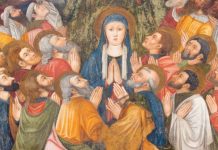
by Jane Bensman
For a more comprehensive Study Guide and Related Readings, see the end of this article.
We have all heard the statement: “The first step is the hardest!” That first step can be the hardest whether we are trying to change a habit or begin a new way of life. Seeing the Beatitudes arranged on a ladder, as presented by Jim Forest in his book titled The Ladder of the Beatitudes (Orbis Books), is a good visual image of how difficult it can be to take that first step to live the Beatitudes intentionally.
Climbing a ladder can be scary, especially if we are afraid of heights. Reaching the top, however, can give us quite a sense of accomplishment. A first step on the ladder of the Beatitudes can be the beginning of an ascent to a whole new way of life or a deeper commitment to continue to grow in relationship with the Lord.
In this article I share what I’ve learned from others and through my own personal reflections about the meaning of the first four Beatitudes on the rungs of the Beatitude ladder—meanings that have a real relationship to my day-to-day living as a Catholic Christian. I have often told my students and others that, if we learn to live the Beatitudes, we don’t have to worry about the Ten Commandments. We will be doing all the right things, and the “shalls” and the “shall nots” will not be issues in our lives.
Understanding “Poor in Spirit”
“Blessed are the poor in spirit for theirs is the Kingdom of Heaven” (Matthew 5:3). The first step in embracing this Beatitude is the most important if we are to continue on the Beatitude ladder. We can be poor physically, emotionally, or spiritually—none of which is easy to experience. For some, being poor happens as a result of circumstances in society. For others, being poor is a decision (i.e., Dorothy Day). But to be truly poor in spirit, I believe, happens gradually.
After doing everything we can to be comfortable, happy, and in control, we gradually realize that the only thing we can depend on for sure is God’s love and care for us. Even those who are very wealthy can be poor in spirit because being poor in spirit means approaching God with.
Learning how to be poor in spirit means living and walking in the light of Christ, like the man born blind in the Scriptures. The man was healed and saw that he was in the presence of the Son of God, the Light of the World—and the man’s world changed. In contrast, a person who is materially poor is not necessarily poor in spirit if he or she continually longs for more and is jealous of those who have more. A person is truly poor in spirit only when he or she recognizes that only God can fulfill all needs.
Mother Teresa said that the greatest poverty is lack of faith and being closed in on oneself. Being poor in spirit means entering into a relationship with Jesus that is freeing and loving. Each of us has been created to be loved. We experience that love in human relationships because it already exists in the love God has for us and our human ability to share this love with others.
Choosing to love in this way includes making a choice to live in relationships over independence. Although there is a push for independence while we’re growing up, we eventually recognize that we are dependent on God and others. Choosing to live in relationships over independence requires loving others as God loves—rather than manipulating others for our own happiness. At times, it even means submission—with love and respect for one another. Christ gave up his independence and died on the cross for us because he loved us.
The Joy of Poverty: So you might wonder: If I can continually work toward being poor in spirit, what is that “Kingdom of God” I will experience? It is an experience of freedom now and ultimately in eternity.
We experience a freedom on this earth—a freedom to stop judging and being judged and trying to change others to fit our standards. We experience mercy, forgiveness, and the freedom to live fully and love all God’s creation with no agenda. We see Christ’s presence and experience his grace, even in the midst of suffering. We walk in the light of Christ. A Franciscan motto says: “The joy of poverty is not to have nothing in this world; the joy of poverty is to have nothing but God.”
Understanding “Mourning”
“Blessed are they who mourn, for they shall be comforted” (Matthew 5:4). I recently sat with a friend whose wife of 39 years was living her last 24 hours on this earth. I came away from that experience pondering even more deeply this Beatitude.
I believe that being poor in spirit is inseparable from mourning. We mourn for ourselves—the sins in our lives and the missed opportunities to turn to Christ—and we mourn for and with others. We mourn those times when we depended on other resources instead of on God. Without a poverty of spirit, we can never completely let our guard down and give freely of everything we have.
Poverty of spirit opens us to the pain of others. Our tears with and for others are Christ’s tears. When we mourn, we must become transparent and open, sharing our pain and loss so we can become compassionate in our understanding of the mourning of those around us. While death and illness are common experiences of mourning, this Beatitude opens us to mourning for those who are hungry, homeless, persecuted, depressed, and mentally ill. We mourn for those who have turned their backs on God and on so many other things; we do not judge them, we mourn for them.
Jesus used the Greek word parakalein for the word “comfort” in this Beatitude. This word means not only to comfort but also to encourage, excite, and urge. Those who mourn will be witnesses to others. As in Acts 2:1-4, after the Holy Spirit—the Paraclete, the Comforter—descended on the Apostles, they burst forth from hiding, ready to be witnesses.
In the same way, those who mourn will be on fire to be comforters to others and to witness to God’s faithfulness. When we mourn we have an ally, a helper, in the Holy Spirit, who exhorts and encourages us to do that which we thought impossible.
Mourning and Comfort: Those of us who mourn are comforted in knowing that Christ is always inviting us to a banquet—not just a banquet where we will be comforted but a banquet where we will be fed and nourished. When we have mourned and found comfort from God, we can be with others who mourn, not to take away their mourning and grief but to help them endure it and, being poor in spirit, turn to God for comfort.
Understanding “Meek”
“Blessed are the meek, for they shall inherit the earth” (Matthew 5:5). Meek is not a word that sounds like something I want to be. Yet, when I looked up the definition of meek, I found this: “one who disciplines self to be gentle, rather than severe; non-violent; bears reproaches and slights; is not bent on revenge; is free from bitterness and belligerence; is tranquil and steady of spirit.”
The definition of the word meek says nothing about being weak or being a doormat for others. It also does not say that we can never be angry about injustice. Rather, being meek means knowing when to get angry and what to do with that anger.
Jesus got angry at those who were self-righteous and hypocritical. He didn’t get angry at those who plotted to arrest him, betrayed him, or denied him. Rather, Jesus was meek. There are many examples in Scripture of Jesus’ meekness. “I am meek and humble of heart” (Matthew 11:29); “Yet not what I want, but what you want” (Matthew 26:39); “Forgive them for they know not what they do” (Luke 23:34). Being meek means believing that goodness can come out of any calamity. It means knowing what to do with our anger in ways that we will inherit the earth.
Inheritance Promised: My maternal grandmother was a meek and strong person. For over 30 years, she cared for my grandfather, crippled from the effects of a devastating disease. She washed his feet many times. My grandmother never complained, was never bitter. Rather, she was tranquil and steady in her love and care for my grandfather.
I know my grandmother inherited the earth—the inheritance that is promised to the meek, the inheritance of all that God has promised to those who believe and follow God’s ways. But first my grandmother was poor in spirit.
Understanding “Hunger and Thirst”
“Blessed are those who hunger and thirst for righteousness, for they shall be satisfied” (Matthew 5:6). This Beatitude does not say we “hope” for righteousness; rather, it says we “hunger and thirst”—we hunger and thirst for righteousness as much as we hunger and thirst for food and drink.
Hungering and thirsting for righteousness is a profound longing for life to be on earth as it is in heaven—which we know is impossible but yet we long for and work for that kind of life. A righteous person is someone in whom others, especially those in need, experience the mercy and love of God.
How can this hunger and thirst be satisfied? First we discern our gifts and talents and develop them for service and in praise for God. Then we use our gifts and talents to support those laws, agencies, and organizations that help and protect the needy in our society. We stand with those who often stand alone in our families, neighborhoods, churches, and world.
In living this Beatitude, we do not just wish for something to happen; rather, we become consumed with the desire to be part of making something happen according to God’s plan and will for all people.
Never Fully Satisfied: What is the satisfaction we can experience as a person who longs for righteousness? Some days we will be very satisfied with the fulfillment of God’s promise through our own works and the work of others according to God’s plan. Other days we will continue to hunger and thirst.
At the end of the day, we will be satisfied that our primary focus was not on food or possessions but on a life in unity with God, a life transformed by love and poor in spirit. While we will never be fully satisfied on this earth, we at least can be grateful that we were awakened to the hunger and the thirst.
Conclusion
How do we increase in our practice of living the Beatitudes? One thought is to view the virtues needed for the Beatitudes as muscles: The more we exercise them the more they will increase in strength. Additionally, calling upon the Holy Spirit to fill us with the Spirit’s gifts and fruits will strengthen us.
In the March 2010 issue of Body & Soul Magazine, an article by Dr. Dacher Keltner from the Greater Good Science Center is summarized with the following conclusion: “Compassion is part of our biology… so doing good is the key to feeling good.” In other studies, neuroscientists have discovered that feeling compassion causes part of the nervous system to light up, including parts of the frontal brain lobes—our emotional control center. It is also associated with the release of oxytocin, the “tend and befriend” hormone which helps calm stress and boosts immune function.
So on a scientific level, we could say that living the Beatitudes boosts our physical health. On a spiritual level, living the Beatitudes gives us the best possible chance to one day hear the words: “Well done, good and faithful servant” (Matthew 25:21, 23; Luke 19:17).
Jane Bensman is experienced in a variety of church ministries over the last 23 years. She has served as the Coordinator for Evangelization and Parish Renewal for the Archdiocese of Cincinnati, Ohio; a Parish Pastoral Associate; a Parish Pastoral Administrator; and Faith Formation Coordinator for Mary Queen of Peace School, Dayton, Ohio.
Study Guide and Related Readings
Jane Bensman begins our introduction to the first four rungs of the ladder of the Beatitudes. Each of the eight Beatitudes describes aspects of being in the Kingdom of God. There is a pattern to the arrangement. Each rung (each Beatitude) leads to the cultivation or preparation for the next one, guiding us toward holiness or fullness of Beatitude living. Focusing in depth on these initial Beatitudes heightens our sensitivity and awareness for our call to and challenges of discipleship.
Discussion/Reflection Questions
1. The metaphor of a ladder for understanding the Beatitudes began with early Church Fathers and continues to the present time. What does this metaphor say to me? How does it enrich my appreciation and understanding of the Beatitudes?
2. What does “blessed are the poor in spirit for theirs is the Kingdom of Heaven” mean for me? Why is this the first rung of the ladder? How can I exercise this Beatitude?
3. Mother Teresa said that the greatest poverty is lack of faith and being closed in on oneself. What does this mean in the present age? Do I experience this poverty in my own life or in the lives of my students? How am I addressing it?
4. What does “blessed are they who mourn, for they shall be comforted” mean for me? How does this rung of the ladder connect with the first rung?
5. What does “blessed are the meek, for they shall inherit the earth” mean for me? How does it relate to the first two rungs of the ladder? What is the integration and grounding toward holiness in these three Beatitudes?
6. What does “blessed are those who hunger and thirst for righteousness, for they shall be satisfied” mean for me? How does this rung of the ladder connect with the previous three rungs? What difference am I beginning to see with this even flow of Beatitude themes?
7. Has my understanding of compassion been enlightened through our Beatitude journey so far? How?
8. After studying chapter 23 and 24 (“Life in Christ—Part One” and “Life in Christ—Part Two”) in the United States Catholic Catechism for Adults, and nos. 42-45 in the National Directory for Catechesis, what ideas can I identify that complement this article?
9. What has been the most significant insight or idea I have gleaned from reading and reflecting on this article for enriching my understanding and living the Beatitudes?
Exercises
1. Prayerfully read and reflect on the first four Beatitudes (Matthew 5:3-6).What personal message, challenge, or invitation do you receive for living these Beatitudes?
2. Create an 8’ to 10’ poster or collage on the ladder of the Beatitudes and place it in a dominant location in your classroom as a continuous reminder of our call to holiness and Beatitude living.
3. Write an essay on Mother Teresa’s words referenced in this article. What do her words mean for living our faith every day? End the composition with a simple prayer or mantra to pray each day in response to Mother Teresa’s words. Memorize it and share it with a friend.
4. Compose a series of prayers or psalms that flow from your appreciation and understanding for Beatitude living, a call to discipleship, and holiness. Post these on the parish or school website. Or begin to compose a Beatitude Prayer Book that may be given as gifts to others at their celebrations of First Holy Communion, the Sacrament of First Penance, or Confirmation.
5. Begin a visual collage (using digital cameras) for the parish entrance way, school hall, or parish/school website on how the students discover the call of Beatitude living within the local community. Or create a Contemporary Beatitude Way of the Cross for Lent.
Related Readings
Dodds, Bill and Michael J. Dodds, O.P. Happily Ever After Begins Here and Now: Living the Beatitudes Today. Chicago: Loyola Press, 1997.
Forest, Jim. The Ladder of the Beatitudes. Maryknoll, NY: Orbis Books, 1999.
Howell, James C. The Beatitudes for Today. Louisville, KY: Westminster John Knox Press, 2006.
Jeremias, Joachim. The Sermon on the Mount Biblical Series. Minneapolis, MN: Fortress Press, 1963.
National Directory for Catechesis. Washington, DC: United States Conference of Catholic Bishops, 2005, nos. 43-46.
Stott, John. The Beatitudes: Developing Spiritual Character. Downers Grove, IL: InterVarsity Press, 1998.
United States Catholic Catechism for Adults. Washington, DC: United States Conference of Catholic Bishops, 2006, chapters 23 and 24.
Copyright 2010, Bayard, Inc. All rights reserved. This article is protected by United States copyright and other intellectual property laws and may not be reproduced, rewritten, distributed, redisseminated, transmitted, displayed, published or broadcast, directly or indirectly, in any medium without the prior written permission of Bayard, Inc.
This article was written by the Catechist Staff and appeared in Catechist magazine, December 2010.
Image Credit: Forest man72/Shutter Stock 659090347




